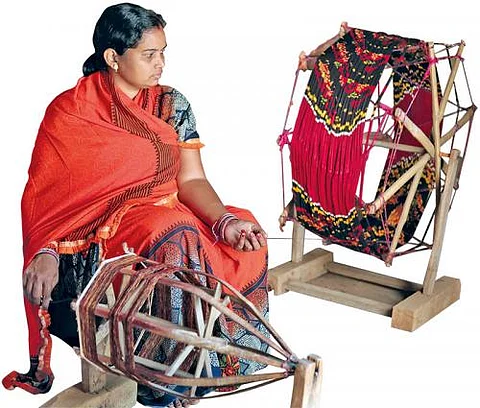

Born to a weaver’s family, Bhagawati Mahananda of Odisha can bring just about any design to life using yarn, a few shuttles and a hand loom. But her skills had gone unnoticed by her family for years. It is her husband, Radhakanta, and father-in-law who used to do all of the weaving at their house in Gambharipali village in Subarnapur district. The district, which is also known as Sonepur, is home to several weaver communities known for the unique Bomkai design, more popularly called Ikat. But over the years, without direct access to the market, remuneration for weavers stagnated and younger generations left home to seek work elsewhere. Those who continued weaving, like Radhakanta, sold the woven fabric to sahukars (local dealers) and earned just Rs 500-700 a month.
After his father’s demise, Radhakanta sought Bhagawati’s help in weaving. Noticing her dexterity, he encouraged her to join the Dungripalli Bunakara Producer Company Limited, Sonepur. “We both now work on the company’s orders and earn Rs 15,000-18,000 a month due to improved operations and steady work,” he says.
Dungripalli Bunakara is a weavers’ producer company that organises weavers in the region and provides them with a steady income. In 2019, Dungripalli Bunakara received financial support from the National Bank for Agriculture and Rural Development (NABARD), Bhubaneswar. “The goal behind the company is to provide guaranteed work to the weavers and to bring in innovation in the craft,” says Pradip Kumar Mahapatra, member-secretary of National Rural Development Council (NRDC), a non-profit headquartered in the district, which was roped in to help the company. To do this, several changes were brought in to the weavers’ work. First, the weavers joining the company were given large warps of yarn with better count, to cut input costs and improve fabric quality. Then, with help from Mumbai-based social entrepreneurship organisation Tisser Artisans Trust and the Indian Institute of Handloom Technology, the weavers learnt new ways of dyeing, colour technology, and bringing in new motifs to the Ikat design. They also began making dress materials and stoles along with traditional saris and dhotis.
The weavers also connected with entrepreneurs, designers and retail sellers in cities such as Bhubaneswar, Visakhapatnam, Hyderabad, Delhi and Mumbai to sell their products, and promoted them at artisan fairs and exhibitions. “As a result of these efforts, the weavers have seen remuneration increase by Rs 4,000-6,000 per month. From 250 weavers in the first year, there are now 675 weaver-shareholders across villages in the district,” says Mahapatra. “Women are now a part of the business. There are fewer school dropouts and people are gaining socio-economic awareness. Fewer people are migrating in search of work,” he says.
Now, with NABARD stepping back, the weavers plan to take over the operations and to grow the company.
This was first published in the 16-30 September, 2023 print edition of Down To Earth